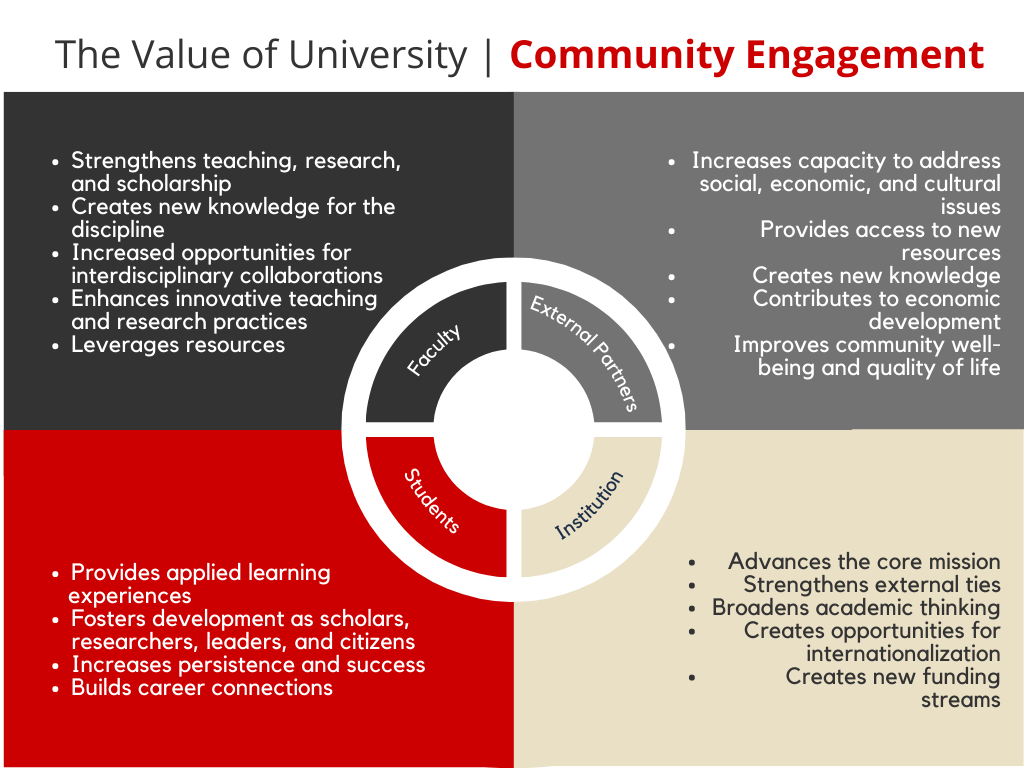Engagement in the College of Human Sciences
Engagement
To engage means connecting the needs and interests of Texas Tech faculty, staff, and students with the needs and interests of communities. By engaging with communities, faculty gain valuable experiences and insights that can inform their teaching, research/creative activity, and service. Students are able to apply their classroom learning to real-world issues, which enhances their overall learning experience and career opportunities. Engaged scholarship describes efforts to connect knowledge generated through faculty research activities that directly impact the public in ways that collaboratively address social issues and community needs.
Key Benefits of Engagement:
- Connects the scholarly interests of faculty, staff, and students across all disciplines with community needs or larger societal concerns;
- Enhances curriculum, teaching and learning;
- Informs research, creative activity, and scholarship;
- Prepares students to become educated and engaged citizens, and
- Addresses critical societal issues and contributes to the public good.
(Carnegie Foundation for the Advancement of Teaching, 2005).
Outreach and Engagement Transformations
Engagement between the university and communities often leads to transformations that none of the partners might have expected or could have achieved on their own. By blending the disciplinary knowledge of faculty, staff, and students with the knowledge and experiences of communities, new knowledge and insights emerge that can transform not only the academy (teaching, research, and scholarship) but also human lives.
THE 10 QUALITIES OF ENGAGEMENT
- Engagement brings the University's intellectual resources to bear on societal needs.
- Engagement is a form of scholarship that cuts across teaching, research, and service.
- Engagement implies reciprocity, whereby both the institutions and partners in the community benefit and contribute.
- Engagement blends scientific knowledge from the university with experiential knowledge within the community to establish an environment of co-learning.
- Engagement involves shared decision-making.
- Engagement is a practice that enables faculty to be better scholars, enhances the learning experience for students, and multiplies the institution's impact on external constituencies.
- Engagement is actively listening to all stakeholders that reflect the diversity of our communities—especially including those stakeholders who have not been engaged before.
- A university is engaged when stakeholders see the institution as the “resource of choice” when dealing with an issue or problem.
- Engagement documents and evaluates its effectiveness through traditional measures of academic excellence.
- The quality of engagement is tied to public accountability and is measured by impact and outcomes on the communities and individuals it serves.
Source: Association of Public and Land-Grant Universities - Council on Engagement and Outreach;
WHAT IS ENGAGED SCHOLARSHIP?
Engaged Scholarship is a form of scholarship that involves collaborative and reciprocal partnerships between the university (faculty, staff, and/or students) and external communities for the mutually beneficial exchange of knowledge and resources. It is creative, intellectual work that relates teaching, research/creative activity, or service to advance specific community interests for the good of the public.
The process merges a faculty member's disciplinary knowledge and expertise with the knowledge and experiences of the community to co-create new knowledge both for the discipline and for the public. Broadly defined, it is scholarly work that is conducted for, in, and with the community or the general public. Engaged scholarship is public, peer reviewed, and publicly available so that others may build on it. It involves a systematic design, implementation, assessment and redesign, and draws from literature and best practices in the discipline. What makes it different from traditional scholarship is the fact that community partners contribute their knowledge and best practices to the research and scholarship.
HOW IS ENGAGED SCHOLARSHIP DIFFERENT FROM TRADITIONAL FACULTY SCHOLARSHIP?
When practicing engaged scholarship, faculty intentionally integrate partnerships with individuals or organization outside of the university into their research and teaching activities for the purpose of addressing a local need or complex societal issue. It is through active collaboration and participation from these community members in the research and solution-seeking process that new knowledge is generated from both the discipline and community partners.
Therefore, engaged scholarship involves both the act of engaging (active collaboration between faculty, staff, and/or students and communities) and the product of engagement (co-creation and dissemination of knew knowledge for the discipline and the community or the general public.) The results are “high quality” peer-reviewed scholarship.
WHAT ARE THE CHARACTERISTICS OF “HIGH QUALITY” ENGAGED SCHOLARSHIP?
- Clear academic and community change goals
- Adequate preparation in content area and grounding in the community
- Appropriate methods: Rigor and engagement with community partners
- Significant results: Impact on the university/field and the community
- Effective presentation/dissemination to academic and community audiences
- Reflective critiques: Lessons learned to improve the scholarship and the engagement
WHAT MAKES AN ENGAGEMENT ACTIVITY “SCHOLARSHIP?”
- It requires a high level of discipline-based expertise
- It breaks new ground or is innovative
- It can be replicated and elaborated
- Its results can be documented
- Its results can be peer reviewed
- It has significance or impact
THE VALUE OF ENGAGEMENT

College of Health & Human Sciences
-
Address
College of Health & Human Sciences, Texas Tech University, P.O. Box 41162, Lubbock, TX 79409-1162 -
Phone
(806) 742-3031 -
Email
hs.webmaster@ttu.edu
